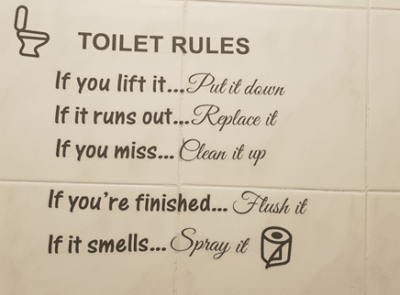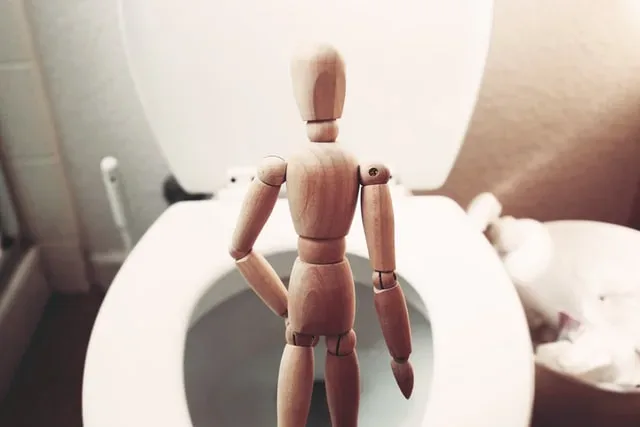Depiction of standing male while peeing | Source: Giorgio Trovato on Unsplash
As the COVID pandemic engulfed human life, a situation which happened to be normal became upside down. The train halted once and almost forever. Buses once spewing black smoke around, getting dusted in the depo. Air of Delhi, which was defiled with the toxic particulate, became crystal clear. So, human life. Once working from home fall under the category of privilege, fell under the category of irksome duty. The tiny bedroom of home became an office. The line demarcating office and work became hotchpotch like the line of control between India and China. As we were forced to get locked inside the room, the ecosystem of the house changed too. One which was barely noticeable became nakedly visible: the smelly bathroom and so that persistent complaint from the spouse. Even if clearing at an unimaginable short interval of seven days, the smell remained adamant. After careful investigation, and cooling down the ego, reason pointed towards my inability to aim at the target which left an unnoticeable trace of a splurge, spatter and splash all around.
Splashes are not unique cases but common across the planet. In accordance with a study conducted by the QS Supplies, 7 in 10 men usually pee standing rather than sitting while at home. 75% try to reduce splashback by aiming at the optimal part; 6 out of 10 admit that they often go hands-free and aiming using directional assistance from hips. Even 40 percent always pee with the toilet seat down. The study also found that peeing while standing covers the toilet and surrounding area with splashback that usually remains unseen. Further, it observes that men who pee while standing most often aim at the rear wall of the toilet bowl (31% of men) and believe this surface minimizes mess – but it is found it creates more unseen splashback than any other aiming technique.
There are no definitive reasons for this male’s urinal behavior. However, some seem more probable—sitting while peeing is considered unmanly, standing while peeing, which is a short phenomenon, avoid contact with the toilet seat, physiology, and design of urinal/bowl which encourage men to pee while standing.
Sitting while peeing is considered unmanly and can be speculated as a tinge of manly ego. As per the same study, roughly 1 in 3 men and 1 in 5 women think it’s ‘unmanly’ if a man usually sits to pee. Putting a hand on hips while urinating is a common sight in male urinal space which depicts the human tendency of occupying more space and a subtle and subconscious depiction of machismo. Another probable reason: Why to sit if it can be done while standing? For males, sitting while peeing is an additional step at cost of sitting, which is a change in body posture and also poses a risk of getting himself soiled by the toilet seat. Male physiology has another important factor that has a great influence on behavior. Last but not the least, the design of urinal/bowl has never encouraged or nudged males to sit while peeing.
The latest development in this field to nudge male to avoid splash is to etch an image of a black house fly onto the bowls of the airport’s urinals. After the flies were added, “spillage” on the men’s-room floor fell by 80%. Though Thaler is not credited with the original idea of drawing flies onto the back of bathroom urinals. However, it is considered a perfect example of Nudge Theory which brought him the Nobel Prize in Economic Sciences in 2017. In this case, attempts were taken to nudge the male to aim better in the urinal. However, no appropriate attempts, so far, were taken to nudge males to avoid splash around the toilet by sitting or alternative posture.
Cultural differences
The world is a culturally diverse place and there is always a different way of doing almost everything. In rural India, males especially the baby-boomer generation pull their sacred thread from the shoulder, revolve it around the ear, and squat in an open area, of course hiding from public attention, for peeing. However, behavior among the younger generation in the same locality is quite different. Definitely, no scared thread and urination while standing are a common sight even if in the open space. In urban India, males usually urinate while standing. It is again due to the usage of a common urinal or squat/western-style toilet which has commonality and somehow designed and encourages the men to pee while standing. In the western world, the western-style toilet is common; evidently, the name of the toilet itself. As per the study conducted by QS Supplies, 70 % of males pee while standing in America and the UK, and a similar trend is observed around.
Peace at home leads to peace in the World
The shared toilet has always been a disputed territory. Definitely, there hadn’t been a full-fledged war for this case, however, the situation often fumes or even simmer as the smell fumes out of the toilet. It is shared by all in the household but visited alone, except few exceptions probably, which leads to speculative arguments of its abuse and end up in endless debate and arguments between men and women.

A study by Panasonic Corporation— an electronic company and also a player in toilet equipment including state-of-the-art heated toilet seats —has determined that as men have been forced to spend more time working from home, they are increasingly migrating from standing up to pee to assuming a seated position.
The study was carried out by a survey with 310 men and women across Japan in August.
Among 155 male participants, 58% confirmed that they already sat down to urinate before the pandemic; however, 11% conveyed that they had switched from standing to sitting in the last six months.
Interviews during the survey uncover some of the reasons behind the change in men’s lavatory habits. These are motivated by two considerations: Avoid the mess left in the spurt, and the desire to keep the spouse happy.
Does it nudge you to sit? Even the idea of peace at home? Hope you have no inclination to fight with fire!
Health benefits
Ever since men had the choice to urinate either standing or sitting, the optimal emptying position has been a topic of discussion in the world of study. A study conducted at Leiden University Medical Center, Netherland found that sitting down helps men with prostate problems such as lower urinary tract disease (LUTS) to urinate with greater force, as the sitting position encourages a “more favorable urodynamic profile.” However, no substantial benefits were noticed for healthy men.
The study offers few explanations: Older men typically succumb to prostate-related issues. At the same time, It is suggested that the fear of falling while standing can result in involuntary contractions of the pelvic muscles to stabilize one’s position which leads to disturbed urinary flow. Such issues are not observed among younger male; hence, sitting doesn’t offer substantial benefits to younger
Another noticeable observation which applies to all regardless of age: While standing, the body goes to great lengths to keep an erect spine and maintain posture. This activates many of the discrete muscles near the hips and pelvis. But when people sit, these pelvic and hip muscles are relaxed which makes urination easier.
Sustainability
The idea to sit while peeing and its association with sustainability should not be mocked with a jeer. Every action on the planet is impacting the planetary resources in some way or another. The world is a place with a limited reserve of almost everything, be it water, minerals, or land and resource must be exploited at an optimal pace, so that it can be sustained in the future. The idea to sit while peeing would help to sustain the exploitation of freshwater to an optimal pace.
Definitely, peeing while standing to leave a mess of splurge and spatter which slowly and silently translates to a fuming smell. It invites and enforces frequent cleaning at the cost of freshwater and chemical which again leave the water intoxicated and need round and round of processing to make it reusable. It turns out to be a vicious cycle of recycling which costs the planet water and energy and burdens it with toxic gases.
Be it sustainability, be it health benefits, or be it peace at home, sitting may have positive impacts; however, the choice is still yours—should you lift or leave the seat resting on the bowl while carrying your business standing, or should the toilet be something we sit on, not aim at!

